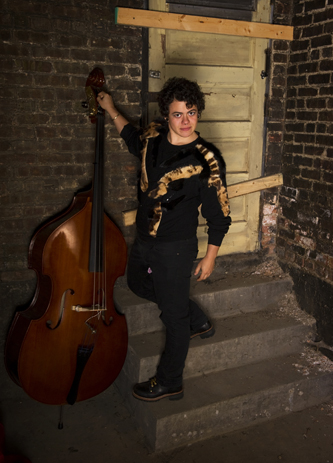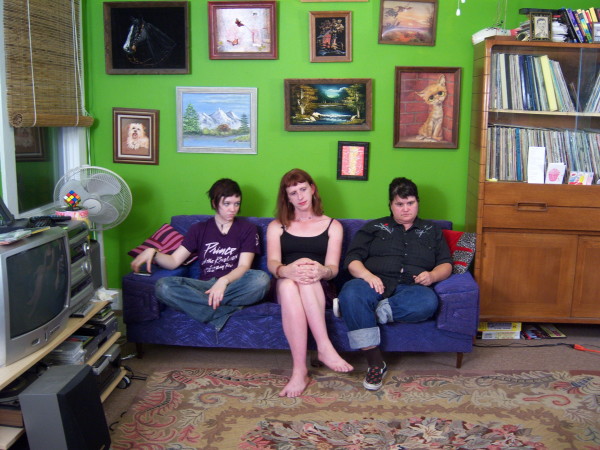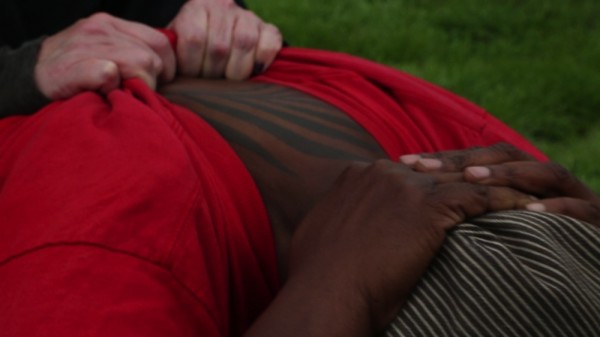Current CORE Resident Madsen Minax hails from Chicago and recently received an Andy Warhol Foundation Idea Fund grant. His film, Riot Acts: Flaunting Gender Deviance in Music Performance, will be screened in Houston on April 24 as part of Q-Fest; he is also organizing a screening of queer shorts called Stinky Pinky at Skydive on April 26. Sasha Dela talked with him here about his project for the Idea Fund, his piece in the Core Show and the upcoming screenings.

Sasha Dela: Madsen, you’re here from Chicago temporarily to attend the Core Program. For the past ten years you lived in Chicago, where you worked with a group of filmmakers and activists to run a screening series called Threat Level Queer Shorts (TQLS). Tell me about the community of short films you are bringing to Houston. Also, would you tell me more about TLQS?
Madsen Minax: Threat Level Queer Shorts was a screening series that ran between 2008 and 2010 and featured queer (broadly defined) short films and videos from around the world. There were ten editions of Threat Level predominantly taking place in Chicago, but the last two took place in both Chicago and Brooklyn. TLQS began as both a community-building and fundraising effort. Myself and the collaborators were working on financially demanding projects at the time (I was working on my film Riot Acts), but we were also seeking to facilitate a space where queer folks could gather that was not the bar/club scene.
The screening I’m bringing to Houston, called Stinky Pinky, is certainly inspired by my work with Threat Level, as it will feature some works that I have curated before, but most of what will screen at Stinky Pinky will be new. In addition, none of the works I am showing have screened in Houston before, so this will really be an excellent opportunity for the artsy queermos to get a glimpse at some fresh and current, not to mention critically engaged, film/video work happening throughout the U.S. (plus a film from Canada and one from Austria!).
SD: You mentioned to me previously that love is a general theme of the screening. Would you tell me about a couple of the shorts? There’s a film you’ve screened before, that you continue to be engaged with, and also there are a few films you have not screened with Threat Level.
MM: Lots of concerns feed into one another with this collection of work, tapping into the idea of love through very different routes. Notions of agency, self-determination, structures of kinship and representation get tackled through use of the abject and camp. The products of those explorations result in appropriated/found footage videos, animated works, mockumentary, essay and portrait films, all of which reinforce a type of enchantment, whether it be in erotics, charm, affection, repulsion, etc.
One of my favorite short films to show is Latham Zearfoss’s experimental video Myth of my Ancestors (2008). It’s a very short (I think three minutes?) video collaboration with a Los Angeles-based artist, Lee Relvas, which utilizes animation/green screen composition and musical performance and arrangement to think about beginnings, becomings and kinships.
I’m also really excited to show Matt Wolf’s little-known short film called I Feel The Love. The video follows a fictitious acquaintance of Andrew Cunanan, the serial killer whose killing spree ending in the assassination of Gianni Versace. It’s a gem overshadowed by his pseudo-mainstream success with his recent films, in particular Wild Combination: A Portrait of Arthur Russell.
I’m also screening New York-based filmmaker Zach Meyer’s short Draconian Romance. It has never screened in the context of “queer” work, yet the video is very queer, and it also incorporates music performance, one of my soft spots. I haven’t screened anything by Wolf or Meyer before, so big excitement!

Film still from Riot Acts
SD: You are also screening one of your own films, Riot Acts: Flaunting Gender Deviance in Music Performance, at Rice on the 24th. Would you tell me a bit about that?
MM: Sure. RA is a documentary film that was in production from 2006-2009, and premiered at film festivals during 2010-2012. Riot Acts uses imagery of travel, journey and a “life on the road” motif to carry viewers through a series of interests and concerns relevant to transgender performers. Through live performance footage and candid interviews, the film navigates thematics of voice performance—singing with a changing voice, or a voice that does not convey the chosen gender expression—sensationalism, spectacle and media representation, notions of “passing” and embodiment. The project was inspired by the slew of imagery stemming from Hollywood since the inception of mainstream cinema—films such as The Crying Game, Ace Ventura, Rent, Crocodile Dundee, Boys Don’t Cry, Patch Adams, Rock Star, etc., etc., all of which pose a transgender existence as one of destitution, isolation, illness and death. Riot Acts suggests that identities and bodies are undeniably political, and the journey within a trans experience isn’t always one of tragedy, but of flux, renewal and becoming.
This film was a huge labor of love, and one that couldn’t have been made without my co-producer, Simon Strikeback, cinematographer, Malic Amayla and oodles of community-motivated support. Riot Acts is screening at the Rice Media Center on Wednesday, April 24 as part of Q Fest’s Shades of Gay (I love this title) program. It is being presented by Dean Daderko, curator at Contemporary Arts Museum Houston, and I’ll be there for a Q&A to follow the film.
SD: What has your experience been with the queer community in Houston? Do you find the diversity here to be similar to Chicago?
MM: This is a tricky question. I think certain locations/communities take a bit longer to tap into because they maybe don’t utilize the same organizational structures that I’m familiar with. That is to say, I’m sure there are plenty of queer things happening in Houston, but I don’t think I’ve been around long enough to tap into the rhythm, let alone make comparisons. From what I can tell, there seems to be a bit more overlap between queer and POC [people of color] communities, which is a relief, but I haven’t seen as much of an overlap between the queer and art worlds, especially the art world that I’m in, which is more conceptually driven than medium-focused.
Built From Memory (Like Some Other Men) at the CORE Exhibition
SD: Your piece at the Core Show consists of a group of box TVs screening various drag and trans reenactments of the infamous animation of Jessica Rabbit. Tell me about your ideas and concerns with this often recreated notion of femininity?
MM: The work I have up in the Core Show right now is called Built From Memory (Like Some Other Men), and takes its motivation from the 1988 film Who Framed Roger Rabbit?, which combines live action with animated characters. There are eight tube television monitors, each showing an excerpt of a different performer reenacting Jessica Rabbit’s infamously racy burlesque number. Certain physical gestures and gyrations have been constructed through digital manipulation. Much of my practice entertains the notion of reveal and the lack thereof. This work is no different in that I give viewers very little imagery to go on. What is there is quickly cascaded upon itself, and there is no discernable male/femaleness, but the influx of ’90s-inspired feminine performance. There is also an overhead audio component playing a recording of myself covering the number performed by Peggy Lee, “Why Don’t You Do Right,” which is also the number playing during Jessica Rabbit’s performance in the original 1988 film. My rendition is influenced by improvised and electronic music, it is experimental and thoroughly imperfect.
As I position it, this work interrogates the nature of femininity and its subsequent construction through re-appropriating and subverting a feminine iconography. Specifically one that is not only born of Hollywood and mainstream production, but is recognized within that format as constructed: her character is animated.
Amongst queer and trans communities, especially feminine spectrum trans communities, the character of Jessica Rabbit, as well as the burlesque scene featured in the film, is largely recognized as a root/route, especially for people of my age range. Many of the images we see growing up directly influence the way we choose to create our gendered selves, calling all assumptions into question. This specific scene is deeply complex, not only because it navigates a highly metonymic animation/live action crux, but because it juggles gender-based power dynamics interrogating sexuality, construction and power simultaneously.
SD: You received an Idea Fund grant for What Good Folks Used to Call Criminal Intimacies, a video project specifically tackling sexual and racial politics. Though these subjects are already explosive on their own, your project will include videos of sex between couples you know. I was able to attend the reception for the Idea Fund Recipients at Aurora Picture Show and saw the preview of your project, which was a couple having sex in a peaceful farm setting. I’ve never seen sex filmed like that before. It was explicit though delicately handled in the cropping of the shots at the same time.
MM: I don’t think of this project as being one about sex, but about erotics. Those erotics are manifest in energies and dynamics that will be just that, without the necessity of the actual act of penetrative sex.
That farm setting rings very different for people of different experiences. Perhaps peaceful for some, or a sight of trauma for others. The interest in this project is to navigate the very slippery space between subversion and reinscription, and specifically to do that under the guise of erotic power dynamics. Because it is still in production, I can’t really speak more at length about what the work does/will do, but it will feature multiple vignettes wherein performers explore consensual power dynamics of an erotic variety.

SD: But I’d like to talk with you more about your way of filming people. The preview film for your Idea Fund project begins as a long shot of a landscape, fog floating on deep green overgrown grass, where cows are grazing, a couple buildings, perhaps used for milking and sheltering animals. The shot includes as well two people engaging in erotic behavior. Perhaps the scene is supposed to gently lull the viewer into a more potentially confrontational sexual encounter? The close shots of the two characters show areas of their bodies embracing one another, as if you are trying to expose us to the tenderness of what they are doing, despite its racially charged and historically problematic interpretations. There is an inherent gentleness and dignity implied by the way you film the characters. What about your own gaze, your own erotics, and how do you negotiate the viewer’s reception of the complex content as essentially a participant?
MM: I don’t quite understand the last question, but I’ll do my best… I feel that because I work specifically with folks that I consider to be part of my community, if not my chosen family, my participation in the work feels organic. I’m being privy to things I’ve been privy to before, often with the same people, so it does feel familiar. The intensity is both moving and challenging.
I don’t feel like I’m trying to “expose” anything. This is reflected in the cinematography, which denies a viewer from witnessing any substantiated acts, but provides intentional space for a re-enactment of sorts. Ultimately because I am editing this work, my gaze cannot be separated. But I prefer to think of the segments not only as my gaze, but as the gaze of the participants too, in that they structure how the scene unfolds, and together we build what it will look like, how it will feel.
For example the folks who appeared in the clip I showed at Aurora were very interested in notions of clowning, physical theater, performance and humor in their own BDSM practice(s). This underpinning interest manifests in the way they negotiate their scene, and in turn becomes recognizable to the audience through the footage. There is audible laughter and facial expressions of joy and amuse.
The cinematic decisions you touched on, the long and close shots, have largely to do with my interest in providing and denying revelations. The viewer is given static long shots that position performers in wide landscapes, barely discernable amongst their surroundings. It cuts between these long shots and extreme close-ups. But not explicit close-ups. I’m not interested in “sex” as it is largely defined. But close-ups that reference physical intimacy and physical struggle at the same time.
Riot Acts: Flaunting Gender Deviance in Music Performance by Madsen Minax is showing as part of the Q-Fest Shades of Gay Film Festival, presented by CAMH curator Dean Dederko, on April 24, 2013 6:30 p.m. at Rice Cinema, on the Campus of Rice University.
Stinky Pinky: A Screening of Queer Shorts featuring works by Kristin Anchor, Rahne Alexander, Zach Meyer, Dorian Bonelli, Tessa Siddle, Chris Vargas, Matt Wolf and Latham Zearfoss, organized by Madsen Minax, screens April 26, 2013 8 p.m. at Skydive Art Space, 2041 Norfolk St., Houston.


